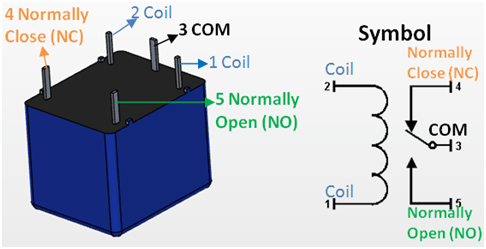AED 2.95
Description
Power relay with a coil voltage rating of 12V DC and SPDT contacts with a 10A rating. The relays have 5 pins and are of very good quality with long service life. compact and sealed construction.
Package Includes:
- 1 x Relay 12V 10A Songle SRD-12VDC-SL-C
Features:
- Switching capacity available by 10A in spite of Small-size design for high-density P.C. board
- Selection of plastic material for high temperatures and better chemical solution performance.
- Simple relay magnetic circuit to meet the low cost of mass production.
- Blue Color.
Description:
Power relay with 10A-rated SPDT contacts and a coil voltage rating of 12V DC. The 5-pin relays are of very high quality and have a long lifespan. construction that is small and sealed. It can trigger high-power electromagnetic contactors and can control small motors, incandescent lamps, indicator lights, low-power power supplies, intelligent instruments, and various solenoid valves. It is especially well suited for tough environments.
Principle of Work:
The iron core of the relay is magnetized when a voltage is delivered to the electromagnetic coil, creating a magnetic field that pulls the armature toward it. This causes the contact to either open if the relay is ordinarily closed or close (closing the load circuit) (depending upon the construction). The load circuit is broken when the voltage is turned off because the spring will force the contacts apart.
Pinout of the Module:

| Pin Name | Description |
| Coil End 1 |
Used to trigger(On/Off) the Relay, Normally one end is connected to 12V and the other end to ground
|
| Coil End 2 |
Used to trigger(On/Off) the Relay, Normally one end is connected to 12V and the other end to ground
|
| Common (COM) |
Common is connected to one End of the Load that is to be controlled
|
| Normally Close (NC) |
The other end of the load is either connected to NO or NC. If connected to NC the load remains connected before trigger
|
| Normally Open (NO) |
The other end of the load is either connected to NO or NC. If connected to NO the load remains disconnected before trigger
|
Applications:
- Relay is used for ON/OFF applications
- Capable of switching multiple circuits
- Coil relays are used for the protection of circuits
- Controls high power circuit with a low-power signal
- For home appliances such as refrigerators, washing machines
- For molding equipment, packing machinery, vending machines
- They are used in Motor & lighting control
- Used in Aerospace, Defense, and automotive industries
- Used in traffic signal controllers, temperature controllers, heaters
- When the supply voltage is other than the rated voltage, a set of relays sense the voltage variations and control the load circuit with the help of circuit breakers.
Circuit:
A relay is used in the circuit depicted in the diagram below to switch 12 volts across a lamp. The program writes a HIGH value to pin 3 to turn on the lamp, activating the optocoupler, which turns on the transistor. A current travels through the relay coil when the transistor is turned on, closing the relay, connecting 12 volts across the motor, and starting it to light up.

Library:
This Module doesn't need a library to work.
Code:
void setup() {
pinMode(3,OUTPUT);
}
void loop() {
digitalWrite(3,HIGH); // motor runs for one sec
delay(1000);
digitalWrite(3,LOW); // motor stops for one sec
delay(1000);
}
Technical Details:
- Model: SRD-12VDC-SL-C
- Material: Plastic, Metal
- Coil-rated voltage: 12V DC
- Max switching current: 10A
- Max switching Voltage: 250VAC
- SPDT contacts
- Dimensions: Approx. 19.2 x 15.5 x 15.2mm/0.75 x 0.61 x 0.59inch
- Mounting Type: DIP
Resources:
Comparisons:
relays use coils, magnetic fields, springs, and mechanical contacts to operate and switch a supply, unlike the solid-state relay (SSR) which has no moving parts and instead performs input-to-output isolation and switching functions using the electrical and optical properties of solid-state semiconductors. electromechanical relays like SSRs, provide complete electrical isolation between their input and output contacts, with their output acting similarly to a conventional electrical switch in that it has a very high, infinite resistance when nonconducting (open) and very low resistance when conducting. the normal relay can hold much more current in comparison to SSR.and the SSR doesn't need an optocoupler to completely isolate the power source side from the output but the SSR already works like an optocoupler.